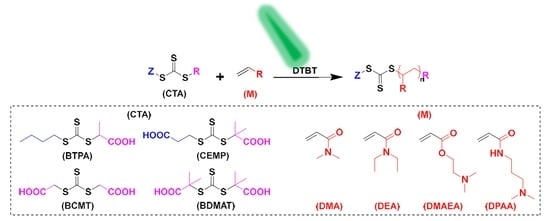PET-RAFT Polymerization Catalyzed by Small Organic Molecule under Green Light Irradiation
Abstract
1. Introduction
2. Materials and Methods
2.1. Materials
2.2. Characterization
2.3. Polymerizations
3. Results and Discussion
4. Conclusions
Supplementary Materials
Author Contributions
Funding
Acknowledgments
Conflicts of Interest
References
- Corrigan, N.; Shanmugam, S.; Xu, J.; Boyer, C. Photocatalysis in organic and polymer synthesis. Chem. Soc. Rev. 2016, 45, 6165–6212. [Google Scholar] [CrossRef]
- Shao, J.; Huang, Y.; Fan, Q. Visible light initiating systems for photopolymerization: Status, development and challenges. Polym. Chem. 2014, 5, 4195–4210. [Google Scholar] [CrossRef]
- Xu, J.; Jung, K.; Atme, A.; Shanmugam, S.; Boyer, C. A Robust and Versatile Photoinduced Living Polymerization of Conjugated and Unconjugated Monomers and Its Oxygen Tolerance. J. Am. Chem. Soc. 2014, 136, 5508–5519. [Google Scholar] [CrossRef]
- Kottisch, V.; Michaudel, Q.; Fors, B.P. Photocontrolled Interconversion of Cationic and Radical Polymerizations. J. Am. Chem. Soc. 2017, 139, 10665–10668. [Google Scholar] [CrossRef]
- Peterson, B.M.; Kottisch, V.; Supej, M.J.; Fors, B.P. On Demand Switching of Polymerization Mechanism and Monomer Selectivity with Orthogonal Stimuli. ACS Central Sci. 2018, 4, 1228–1234. [Google Scholar] [CrossRef]
- Shanmugam, S.; Boyer, C. Stereo-, Temporal and Chemical Control through Photoactivation of Living Radical Polymerization: Synthesis of Block and Gradient Copolymers. J. Am. Chem. Soc. 2015, 137, 9988–9999. [Google Scholar] [CrossRef] [PubMed]
- Zhang, Z.; Zeng, T.-Y.; Xia, L.; Hong, C.-Y.; Wu, D.-C.; You, Y.-Z. Synthesis of polymers with on-demand sequence structures via dually switchable and interconvertible polymerizations. Nat. Commun. 2018, 9, 2577. [Google Scholar] [CrossRef]
- Xu, J.; Fu, C.; Shanmugam, S.; Hawker, C.J.; Moad, G.; Boyer, C. Synthesis of Discrete Oligomers by Sequential PET-RAFT Single-Unit Monomer Insertion. Angew. Chem. Int. Ed. 2017, 56, 8376–8383. [Google Scholar] [CrossRef] [PubMed]
- Fors, B.P.; Hawker, C.J. Control of a Living Radical Polymerization of Methacrylates by Light. Angew. Chem. Int. Ed. 2012, 51, 8850–8853. [Google Scholar] [CrossRef]
- Treat, N.J.; Fors, B.P.; Kramer, J.W.; Christianson, M.; Chiu, C.-Y.; de Alaniz, J.R.; Hawker, C.J. Controlled Radical Polymerization of Acrylates Regulated by Visible Light. ACS Macro Lett. 2014, 3, 580–584. [Google Scholar] [CrossRef]
- Poelma, J.E.; Fors, B.P.; Meyers, G.F.; Kramer, J.W.; Hawker, C.J. Fabrication of Complex Three-Dimensional Polymer Brush Nanostructures through Light-Mediated Living Radical Polymerization. Angew. Chem. Int. Ed. 2013, 52, 6844–6848. [Google Scholar] [CrossRef]
- Xu, J.; Jung, K.; Boyer, C. Oxygen Tolerance Study of Photoinduced Electron Transfer-Reversible Addition-Fragmentation Chain Transfer (PET-RAFT) Polymerization Mediated by Ru(bpy)(3)Cl-2. Macromolecules 2014, 47, 4217–4229. [Google Scholar] [CrossRef]
- Shanmugam, S.; Xu, J.; Boyer, C. Exploiting Metalloporphyrins for Selective Living Radical Polymerization Tunable over Visible Wavelengths. J. Am. Chem. Soc. 2015, 137, 9174–9185. [Google Scholar] [CrossRef] [PubMed]
- Corrigan, N.; Xu, J.; Boyer, C. A Photoinitiation System for Conventional and Controlled Radical Polymerization at Visible and NIR Wavelengths. Macromolecules 2016, 49, 3274–3285. [Google Scholar] [CrossRef]
- Kottisch, V.; Supej, M.J.; Fors, B.P. Enhancing Temporal Control and Enabling Chain-End Modification in Photoregulated Cationic Polymerizations by Using Iridium-Based Catalysts. Angew. Chem. Int. Ed. 2018, 57, 8260–8264. [Google Scholar] [CrossRef] [PubMed]
- Dadashi-Silab, S.; Pan, X.; Matyjaszewski, K. Photoinduced Iron-Catalyzed Atom Transfer Radical Polymerization with ppm Levels of Iron Catalyst under Blue Light Irradiation. Macromolecules 2017, 50, 7967–7977. [Google Scholar] [CrossRef]
- Shanmugam, S.; Xu, J.; Boyer, C. Utilizing the electron transfer mechanism of chlorophyll a under light for controlled radical polymerization. Chem. Sci. 2015, 6, 1341–1349. [Google Scholar] [CrossRef]
- Shanmugam, S.; Xu, J.; Boyer, C. Light-Regulated Polymerization under Near-Infrared/Far-Red Irradiation Catalyzed by Bacteriochlorophyll a. Angew. Chem. Int. Ed. 2016, 55, 1036–1040. [Google Scholar] [CrossRef]
- Ma, W.; Chen, D.; Ma, Y.; Wang, L.; Zhao, C.; Yang, W. Visible-light induced controlled radical polymerization of methacrylates with Cu(dap)(2)Cl as a photoredox catalyst. Polym. Chem. 2016, 7, 4226–4236. [Google Scholar] [CrossRef]
- Xu, J.; Shanmugam, S.; Duong, H.T.; Boyer, C. Organo-photocatalysts for photoinduced electron transfer-reversible addition-fragmentation chain transfer (PET-RAFT) polymerization. Polym. Chem. 2015, 6, 5615–5624. [Google Scholar] [CrossRef]
- Theriot, J.C.; Lim, C.-H.; Yang, H.; Ryan, M.D.; Musgrave, C.B.; Miyake, G.M. Organocatalyzed atom transfer radical polymerization driven by visible light. Science 2016, 352, 1082–1086. [Google Scholar] [CrossRef]
- Treat, N.J.; Sprafke, H.; Kramer, J.W.; Clark, P.G.; Barton, B.E.; de Alaniz, J.R.; Fors, B.P.; Hawker, C.J. Metal-Free Atom Transfer Radical Polymerization. J. Am. Chem. Soc. 2014, 136, 16096–16101. [Google Scholar] [CrossRef]
- Pearson, R.M.; Lim, C.-H.; McCarthy, B.G.; Musgrave, C.B.; Miyake, G.M. Organocatalyzed Atom Transfer Radical Polymerization Using N-Aryl Phenoxazines as Photoredox Catalysts. J. Am. Chem. Soc. 2016, 138, 11399–11407. [Google Scholar] [CrossRef]
- Jiang, J.; Ye, G.; Wang, Z.; Lu, Y.; Chen, J.; Matyjaszewski, K. Heteroatom-Doped Carbon Dots (CDs) as a Class of Metal-Free Photocatalysts for PET-RAFT Polymerization under Visible Light and Sunlight. Angew. Chem. Int. Ed. 2018, 57, 12037–12042. [Google Scholar] [CrossRef]
- Yang, Q.; Zhang, X.; Ma, Y.; Chen, D.; Yang, W. Visible-light induced RAFT polymerization of styrenic monomers with aromatic aldehydes as organophotoredox catalysts. J. Polym. Sci. Pol. Chem. 2018, 56, 2072–2079. [Google Scholar] [CrossRef]
- Yang, Q.; Zhang, X.; Ma, W.; Ma, Y.; Chen, D.; Wang, L.; Zhao, C.; Yang, W. Visible light-induced RAFT polymerization of methacrylates with benzaldehyde derivatives as organophotoredox catalysts. J. Polym. Sci. Pol. Chem. 2018, 56, 229–236. [Google Scholar] [CrossRef]
- Liu, X.; Zhang, L.; Cheng, Z.; Zhu, X. Metal-free photoinduced electron transfer-atom transfer radical polymerization (PET-ATRP) via a visible light organic photocatalyst. Polym. Chem. 2016, 7, 689–700. [Google Scholar] [CrossRef]
- Tu, K.; Xu, T.; Zhang, L.; Cheng, Z.; Zhu, X. Visible light-induced PET-RAFT polymerization of methacrylates with novel organic photocatalysts. RSC Adv. 2017, 7, 24040–24045. [Google Scholar] [CrossRef]
- Huang, Z.; Gu, Y.; Liu, X.; Zhang, L.; Cheng, Z.; Zhu, X. Metal-Free Atom Transfer Radical Polymerization of Methyl Methacrylate with ppm Level of Organic Photocatalyst. Macromol. Rapid Commun. 2017, 38, 1600461. [Google Scholar] [CrossRef] [PubMed]
- Ohtsuki, A.; Goto, A.; Kaji, H. Visible-Light-Induced Reversible Complexation Mediated Living Radical Polymerization of Methacrylates with Organic Catalysts. Macromolecules 2013, 46, 96–102. [Google Scholar] [CrossRef]
- Ohtsuki, A.; Lei, L.; Tanishima, M.; Goto, A.; Kaji, H. Photocontrolled Organocatalyzed Living Radical Polymerization Feasible over a Wide Range of Wavelengths. J. Am. Chem. Soc. 2015, 137, 5610–5617. [Google Scholar] [CrossRef]
- Trotta, J.T.; Fors, B.P. Organic Catalysts for Photocontrolled Polymerizations. Synlett 2016, 27, 702–713. [Google Scholar]
- Kottisch, V.; Michaudel, Q.; Fors, B.P. Cationic Polymerization of Vinyl Ethers Controlled by Visible Light. J. Am. Chem. Soc. 2016, 138, 15535–15538. [Google Scholar] [CrossRef]
- Michaudel, Q.; Chauvire, T.; Kottisch, V.; Supej, M.J.; Stawiasz, K.J.; Shen, L.; Zipfel, W.R.; Abruna, H.D.; Freed, J.H.; Fors, B.P. Mechanistic Insight into the Photocontrolled Cationic Polymerization of Vinyl Ethers. J. Am. Chem. Soc. 2017, 139, 15530–15538. [Google Scholar] [CrossRef]
- Perkowski, A.J.; You, W.; Nicewicz, D.A. Visible Light Photoinitiated Metal-Free Living Cationic Polymerization of 4-Methoxystyrene. J. Am. Chem. Soc. 2015, 137, 7580–7583. [Google Scholar] [CrossRef]
- Ogawa, K.A.; Goetz, A.E.; Boydston, A.J. Metal-Free Ring-Opening Metathesis Polymerization. J. Am. Chem. Soc. 2015, 137, 1400–1403. [Google Scholar] [CrossRef]
- Yagci, Y.; Hepuzer, Y. A novel visible light initiatiating system for cationic polymerization. Macromolecules 1999, 32, 6367–6370. [Google Scholar] [CrossRef]
- Aydogan, B.; Gundogan, A.S.; Ozturk, T.; Yagci, Y. A dithienothiophene derivative as a long-wavelength photosensitizer for onium salt photoinitiated cationic polymerization. Macromolecules 2008, 41, 3468–3471. [Google Scholar] [CrossRef]
- Yilmaz, G.; Aydogan, B.; Temel, G.; Arsu, N.; Moszner, N.; Yagci, Y. Thioxanthone-Fluorenes as Visible Light Photoinitiators for Free Radical Polymerization. Macromolecules 2010, 43, 4520–4526. [Google Scholar] [CrossRef]
- Yilmaz, G.; Beyazit, S.; Yagci, Y. Visible Light Induced Free Radical Promoted Cationic Polymerization Using Thioxanthone Derivatives. J. Polym. Sci. Pol. Chem. 2011, 49, 1591–1596. [Google Scholar] [CrossRef]
- Kiskan, B.; Zhang, J.; Wang, X.; Antonietti, M.; Yagci, Y. Mesoporous Graphitic Carbon Nitride as a Heterogeneous Visible Light Photoinitiator for Radical Polymerization. ACS Macro Lett. 2012, 1, 546–549. [Google Scholar] [CrossRef]
- Dadashi-Silab, S.; Bildirir, H.; Dawson, R.; Thomas, A.; Yagci, Y. Microporous Thioxanthone Polymers as Heterogeneous Photoinitiators for Visible Light Induced Free Radical and Cationic Polymerizations. Macromolecules 2014, 47, 4607–4614. [Google Scholar] [CrossRef]
- Erdur, S.; Yilmaz, G.; Colak, D.G.; Cianga, I.; Yagci, Y. Poly(phenylenevinylene)s as Sensitizers for Visible Light Induced Cationic Polymerization. Macromolecules 2014, 47, 7296–7302. [Google Scholar] [CrossRef]
- Sangermano, M.; Rodriguez, D.; Gonzalez, M.C.; Laurenti, E.; Yagci, Y. Visible Light Induced Cationic Polymerization of Epoxides by Using Multiwalled Carbon Nanotubes. Macromol. Rapid Commun. 2018, 39, 1800250. [Google Scholar] [CrossRef] [PubMed]
- Mishra, A.; Baeuerle, P. Small Molecule Organic Semiconductors on the Move: Promises for Future Solar Energy Technology. Angew. Chem. Int. Ed. 2012, 51, 2020–2067. [Google Scholar] [CrossRef] [PubMed]
- Wang, L.; Li, R.; Zhang, K.A.I. Atom Transfer Radical Polymerization (ATRP) Catalyzed by Visible Light-Absorbed Small Molecule Organic Semiconductors. Macromol. Rapid Commun. 2018, 39, 1800466. [Google Scholar] [CrossRef] [PubMed]
- Aydogan, B.; Yagci, Y.; Toppare, L.; Jockusch, S.; Turro, N.J. Photoinduced Electron Transfer Reactions of Highly Conjugated Thiophenes for Initiation of Cationic Polymerization and Conjugated Polymer Formation. Macromolecules 2012, 45, 7829–7834. [Google Scholar] [CrossRef]
- Wang, L.; Huang, W.; Li, R.; Gehrig, D.; Blom, P.W.M.; Landfester, K.; Zhang, K.A.I. Structural Design Principle of Small-Molecule Organic Semiconductors for Metal-Free, Visible-Light-Promoted Photocatalysis. Angew. Chem. Int. Ed. 2016, 55, 9783–9787. [Google Scholar] [CrossRef]
- Skrabania, K.; Miasnikova, A.; Bivigou-Koumba, A.M.; Zehm, D.; Laschewsky, A. Examining the UV-vis absorption of RAFT chain transfer agents and their use for polymer analysis. Polym. Chem. 2011, 2, 2074–2083. [Google Scholar] [CrossRef]
- Carmean, R.N.; Becker, T.E.; Sims, M.B.; Sumerlin, B.S. Ultra-High Molecular Weights via Aqueous Reversible-Deactivation Radical Polymerization. Chem 2017, 2, 93–101. [Google Scholar] [CrossRef]
- Lu, L.; Zhang, H.; Yang, N.; Cai, Y. Toward rapid and well-controlled ambient temperature RAFT polymerization under UV-Vis radiation: Effect of radiation wave range. Macromolecules 2006, 39, 3770–3776. [Google Scholar] [CrossRef]
- McKenzie, T.G.; Fu, Q.; Wong, E.H.H.; Dunstan, D.E.; Qiao, G.G. Visible Light Mediated Controlled Radical Polymerization in the Absence of Exogenous Radical Sources or Catalysts. Macromolecules 2015, 48, 3864–3872. [Google Scholar] [CrossRef]
- McKenzie, T.G.; Costa, L.P.d.M.; Fu, Q.; Dunstan, D.E.; Qiao, G.G. Investigation into the photolytic stability of RAFT agents and the implications for photopolymerization reactions. Polym. Chem. 2016, 7, 4246–4253. [Google Scholar] [CrossRef]
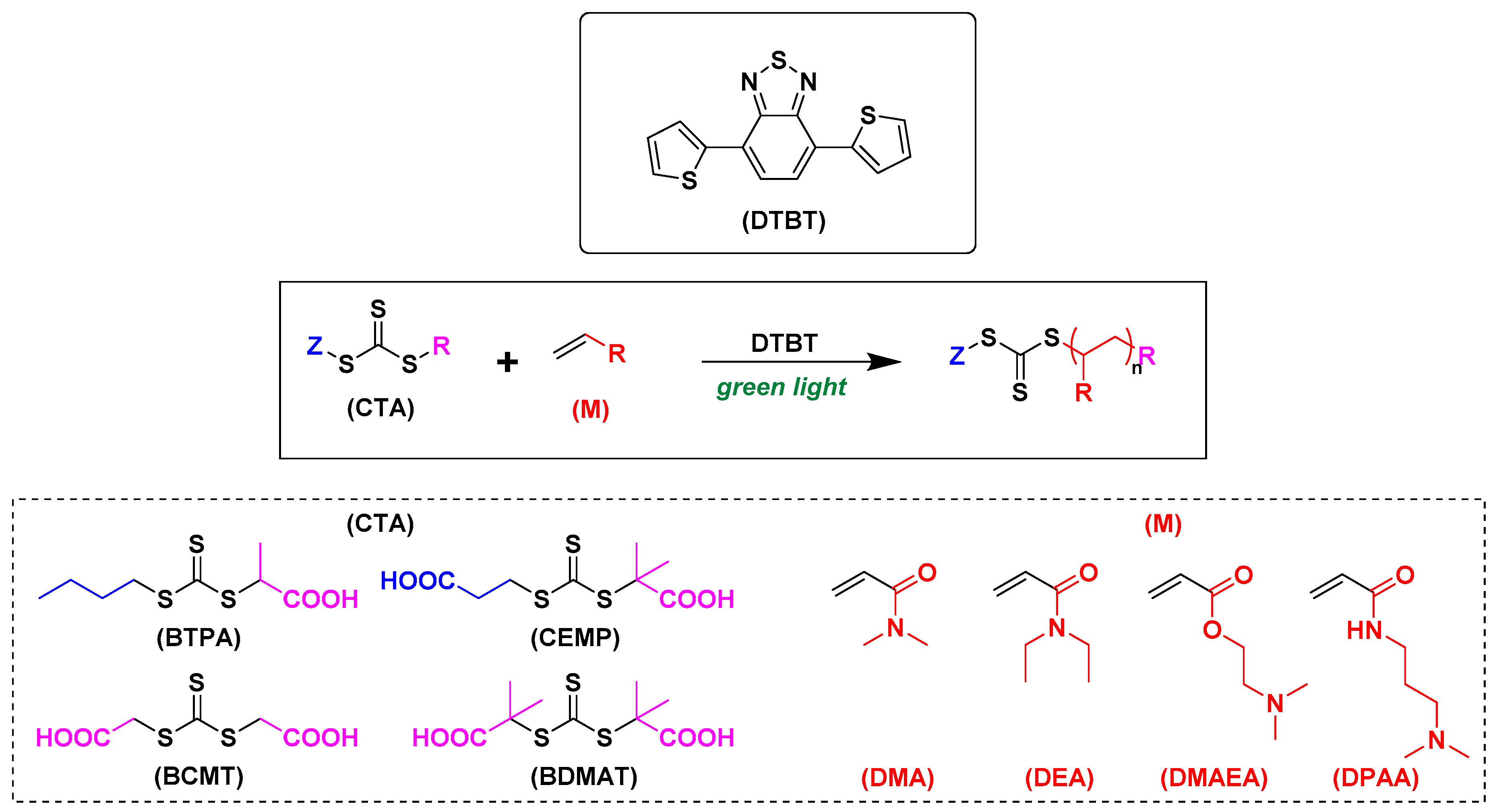
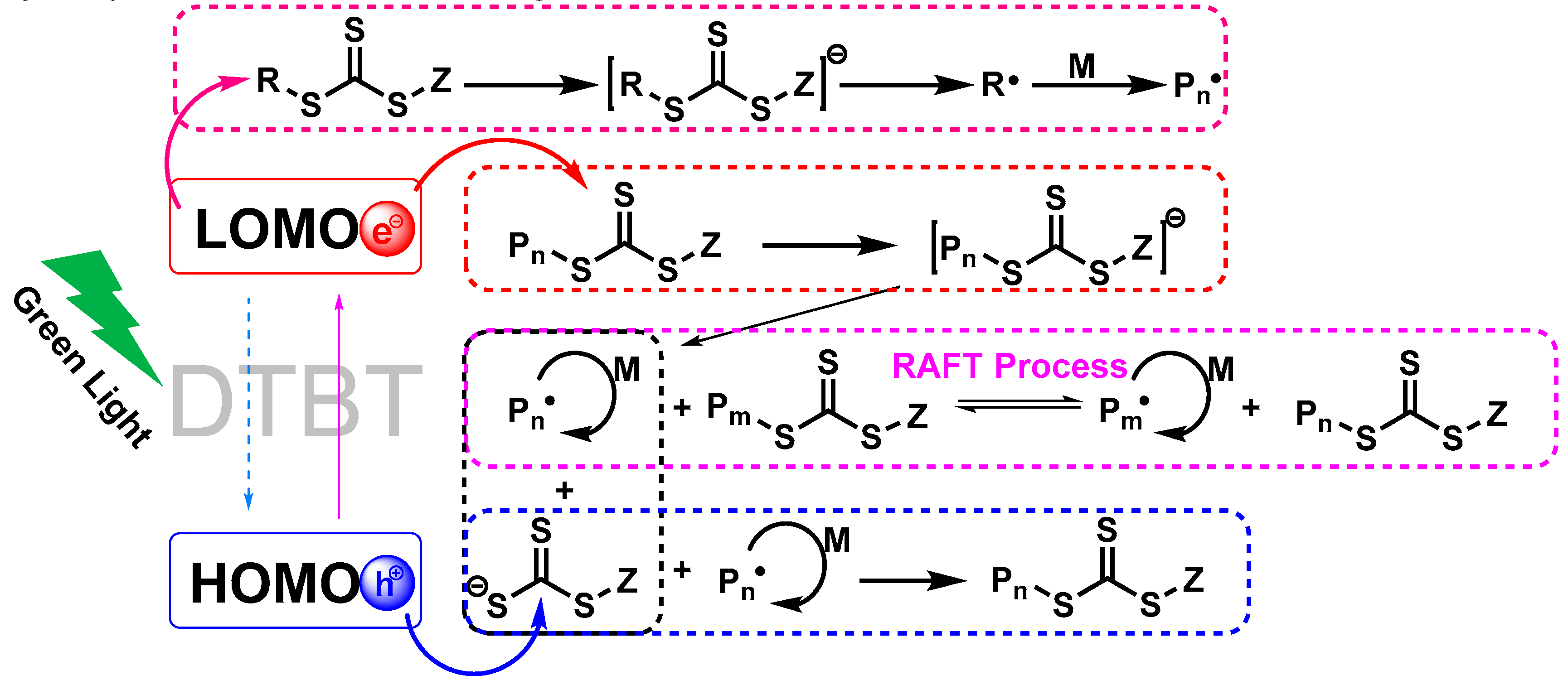
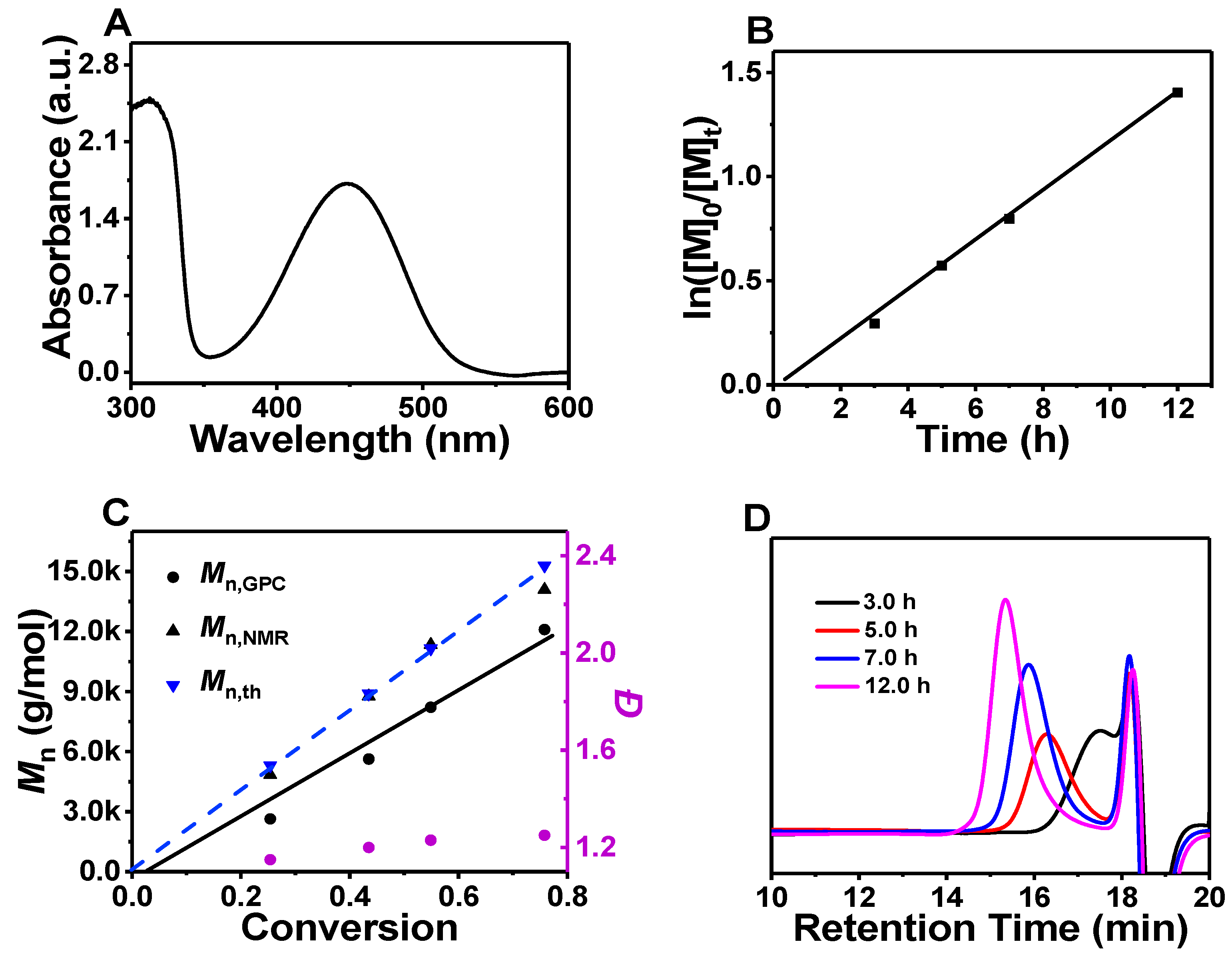

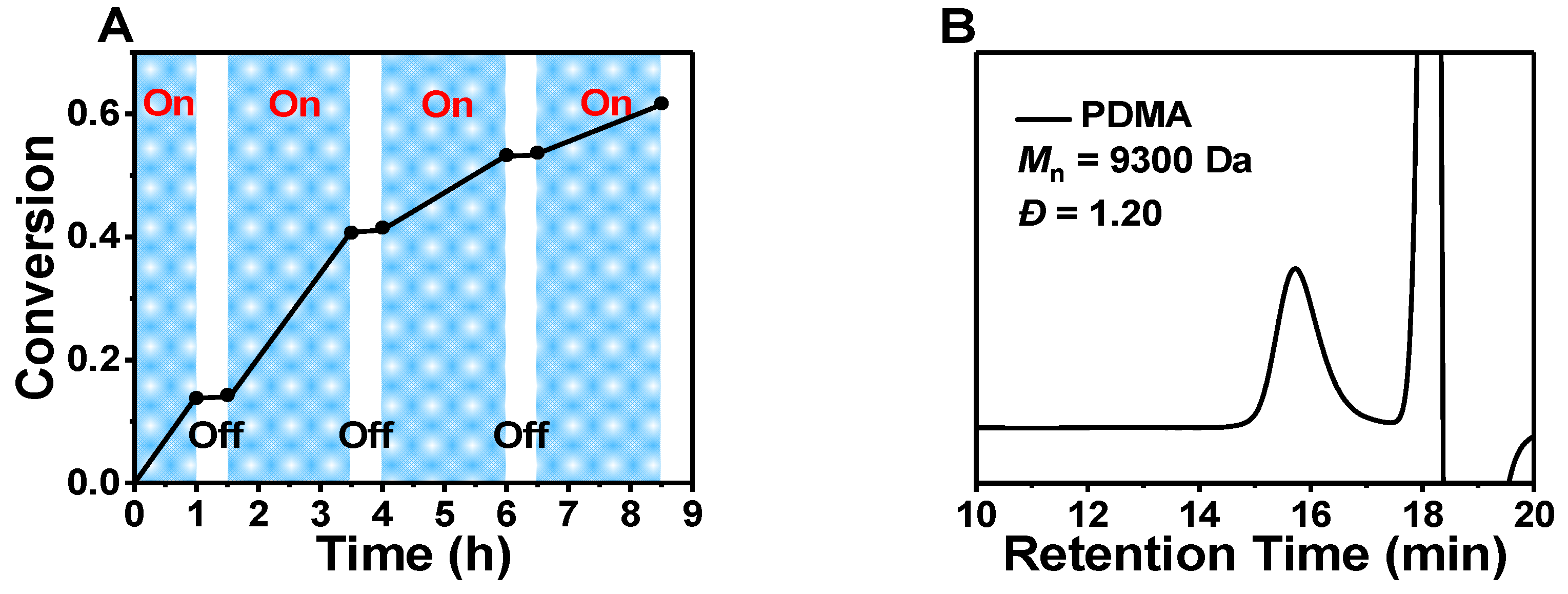
| Entry | [DMA]0:[CEMP]0:[DTBT]0 | conv. (%) d | Mn,the (Da) | Mn,GPCf (Da) | Đf |
|---|---|---|---|---|---|
| 1 | 200:1:0.1 | 78.9 | 15900 | 11600 | 1.23 |
| 2 | 200:1:0.2 | 87.5 | 17500 | 12700 | 1.25 |
| 3 | 200:1:0.02 | 50.0 | 10170 | 6200 | 1.32 |
| 4 b | 200:1:0.1 | 0 | 0 | - | - |
| 5 | 200:1:0 | 0 | 0 | - | - |
| 6 c | 200:1:0 | 18.0 | 2830 | - | - |
| 7 | 200:1:0.1 | 2.0 | 660 | - | - |
| Entry | CTA | Monomer | conv. (%) b | Mn,thc (Da) | Mn,GPCd (Da) | Đd |
|---|---|---|---|---|---|---|
| 1 | S, S′-bis(α, α′-dimethyl-α″-acetic acid)trithiocarbonate (BDMAT) | DMA | 65.7 | 13300 | 7700 | 1.62 |
| 2 | 2-(n-butyltrithiocarbonate)-propionic acid (BTPA) | DMA | 35.1 | 7190 | 2400 | 1.40 |
| 3 | bis(carboxymethyl) trithiocarbonate (BCMT) | DMA | 45.2 | 9180 | 7300 | 1.63 |
| 4 | CEMP | DEA | 85.9 | 21800 | 12040 | 1.31 |
| 5 | CEMP | DMAEA | 61.5 | 17900 | 25500 | 1.38 |
| 6 | CEMP | DPAA | 57.6 | 18200 | 6540 | 1.27 |
© 2019 by the authors. Licensee MDPI, Basel, Switzerland. This article is an open access article distributed under the terms and conditions of the Creative Commons Attribution (CC BY) license (http://creativecommons.org/licenses/by/4.0/).
Share and Cite
Tao, H.; Xia, L.; Chen, G.; Zeng, T.; Nie, X.; Zhang, Z.; You, Y. PET-RAFT Polymerization Catalyzed by Small Organic Molecule under Green Light Irradiation. Polymers 2019, 11, 892. https://doi.org/10.3390/polym11050892
Tao H, Xia L, Chen G, Zeng T, Nie X, Zhang Z, You Y. PET-RAFT Polymerization Catalyzed by Small Organic Molecule under Green Light Irradiation. Polymers. 2019; 11(5):892. https://doi.org/10.3390/polym11050892
Chicago/Turabian StyleTao, Huazhen, Lei Xia, Guang Chen, Tianyou Zeng, Xuan Nie, Ze Zhang, and Yezi You. 2019. "PET-RAFT Polymerization Catalyzed by Small Organic Molecule under Green Light Irradiation" Polymers 11, no. 5: 892. https://doi.org/10.3390/polym11050892
APA StyleTao, H., Xia, L., Chen, G., Zeng, T., Nie, X., Zhang, Z., & You, Y. (2019). PET-RAFT Polymerization Catalyzed by Small Organic Molecule under Green Light Irradiation. Polymers, 11(5), 892. https://doi.org/10.3390/polym11050892



